The other day at work, I overheard my supervisor and another tool maker debate on what they should do about a Trim die punch that was continually dulling well before the preventative maintenance was scheduled on the die. They argued whether the punch should be made of D2 or A1 tooling steel.
The application in question is a circular die punch approximately 1.250” in diameter that is punching through 0.050 thick aluminum alloy. The punch would completely break out on the part only after 500-1000 cycles when the die is scheduled for maintenance every 6000 thousand cycles as I heard them go back and forth on whether the punch was engineered correctly or if they should change it. The trim die was engineered to use A2 steel, and the tool makers felt it would perform better if the punch were made of D2. Let us look at A2 and D2 steel, their differences, and the “right” theoretical application.
What is A1 steel, and what are its applications
A1 steel is a Low-alloy, high-carbon steel with 0.9% to 1% carbon contents with small amounts of chromium, molybdenum and Vanadium. A1 is a hardened steel with a Rockwell hardness of 57-59 HRC, A1 is a tough steel but often not considered tougher than D2. A1 had poor corrosion resistance and required regular maintenance to prevent corrosion. A1 is usually the right choice for good toughness and moderate hardness with some wear resistance in steel. Usually a good choice for making woodworking tools, chisels and food knife blades. Because of its toughness and hardness, it can be used in some automotive and aerospace applications.
What is D2 tool steel, and what are its applications?
D2 steel is a high carbon with 1.4-1.6% and high chromium steel with 12-13% steel. It also contains small amounts of vanadium molybdenum and vanadium. D2 steel is considered very hard tooling steel with a Rockwell hardness of 60-62 HRC and good wear resistance, making it a good steel for applications requiring tough durability steel. D2 is also corrosion-resistant because of the higher chromium content this will also lead to it being more expensive than A1 steel. D2 steel is commonly used for industrial cutting tools, such as punches and dies, as well as moulds for plastics, usually in high-performance tools typically found in auto and aerospace applications.
Now that we have examined the characteristics of both types of steel and their application, D2 steel sounds like the best type for the application.
Both tradesmen went back and forth without agreeing. Thus, we decided to make a D2 punch in-house, install it in a trimming Die, and run an experiment to see if the tool would behave as the tooling steel characteristics are described. And whether the D2 punch would last longer than the A2 steel without dulling prematurely.
The A2 punch was scheduled to last 6000 cycles and was barely lasting 2000 cycles the in-house D2 punch was lasting well past the 6000 cycles without needing any sharpening. This lead me to conclude that even though the A2 punch is much cheaper, it won’t last long enough and will lead to lost production time. The D2 punch may be over-engineered for the application because it can last much longer than 6000 cycles, which is the preventative maintenance schedule of the tool. Still, it will also not cause any downtime or loss of productive time, leading me to believe that even though it’s a more expensive material, the company will make up the added cost with increased production time.
In conclusion, this die had been running with the D2 punches in production for over two years with no changes.
Steel specifications were used from www.steelexpress.co


